Featured Comment:
“Thanks for the hack, I tried it with long curly spaghetti to make ramen at home, it was pretty good.”
– Didina Gnagnide Angorinie
Finding Ramen Noodles Abroad Can Be Tricky
A common problem Japanese ramen lovers like myself face when living abroad is the fact that there aren’t ramen restaurants on every corner like back home. When I lived in a small city in England for years, I always had this problem of not being able to find ramen.
Of course, it would be absolutely wrong to expect the same environment in other countries as in Japan, but I grew up with ramen and my occasional craving for it will probably never disappear.
Can cup noodles or instant noodles satisfy that craving? Unfortunately, no. Of course, I like cup noodles too, but I consider ramen from a ramen restaurant and cup noodles to be two completely different dishes.
Here is my personal opinion on whether or not I recommend against known measures for such a problem of not being able to reach ramen from my experience.
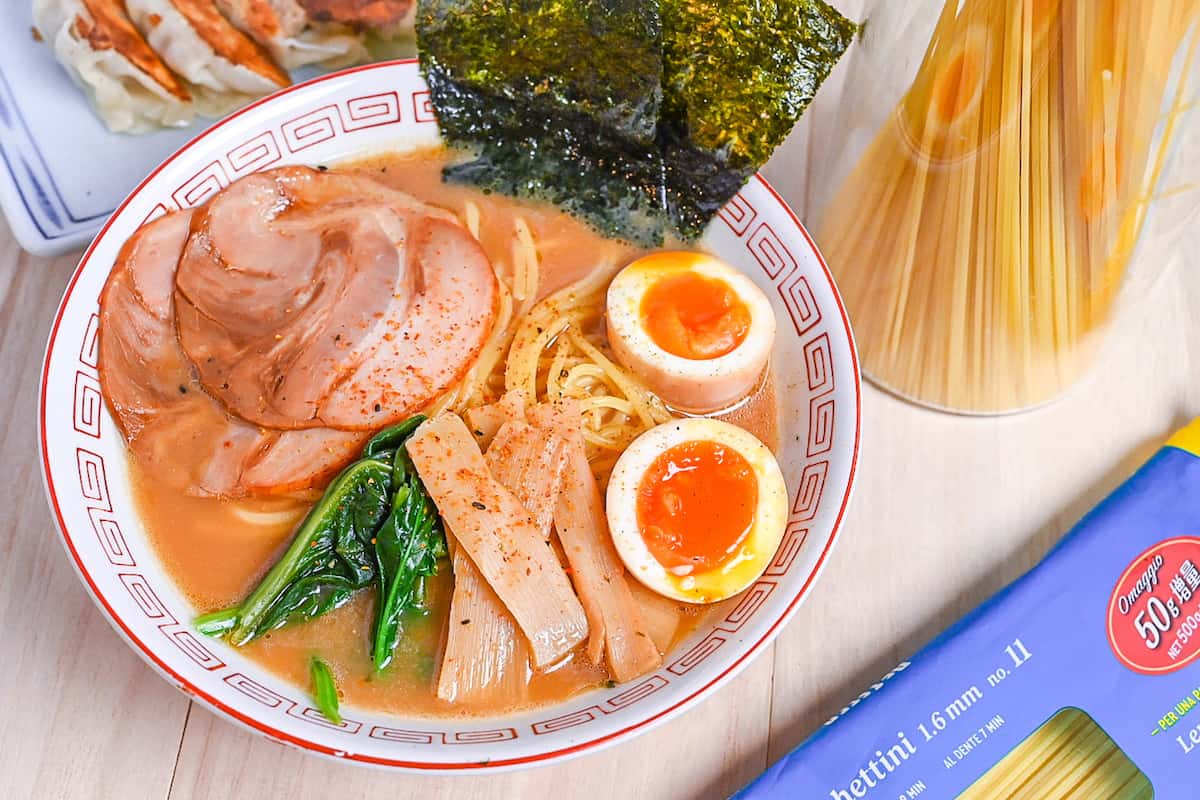
Making it from scratch at home
My first attempt to tackle the ramen puzzle was to roll up my sleeves and try making the noodles from scratch at home. Believe me, it’s not for the faint of heart. Between assembling the ingredients and wrestling with a manual pasta machine, it was a messy affair that tested my patience back then!
The result was quite a triumph I must say but, it was quite a hassle! Making the soup and chashu from scratch alone requires time and effort. Add homemade noodles into the mix, turning into a day-long culinary marathon. Another drawback is the need for equipment such as a pasta machine.

So, while creating authentic ramen noodles at home is entirely possible, it’s also a commitment – of time, effort, and extra cleaning. If you ask me, I wholeheartedly recommend trying homemade ramen noodles, but only if you have time to spare.
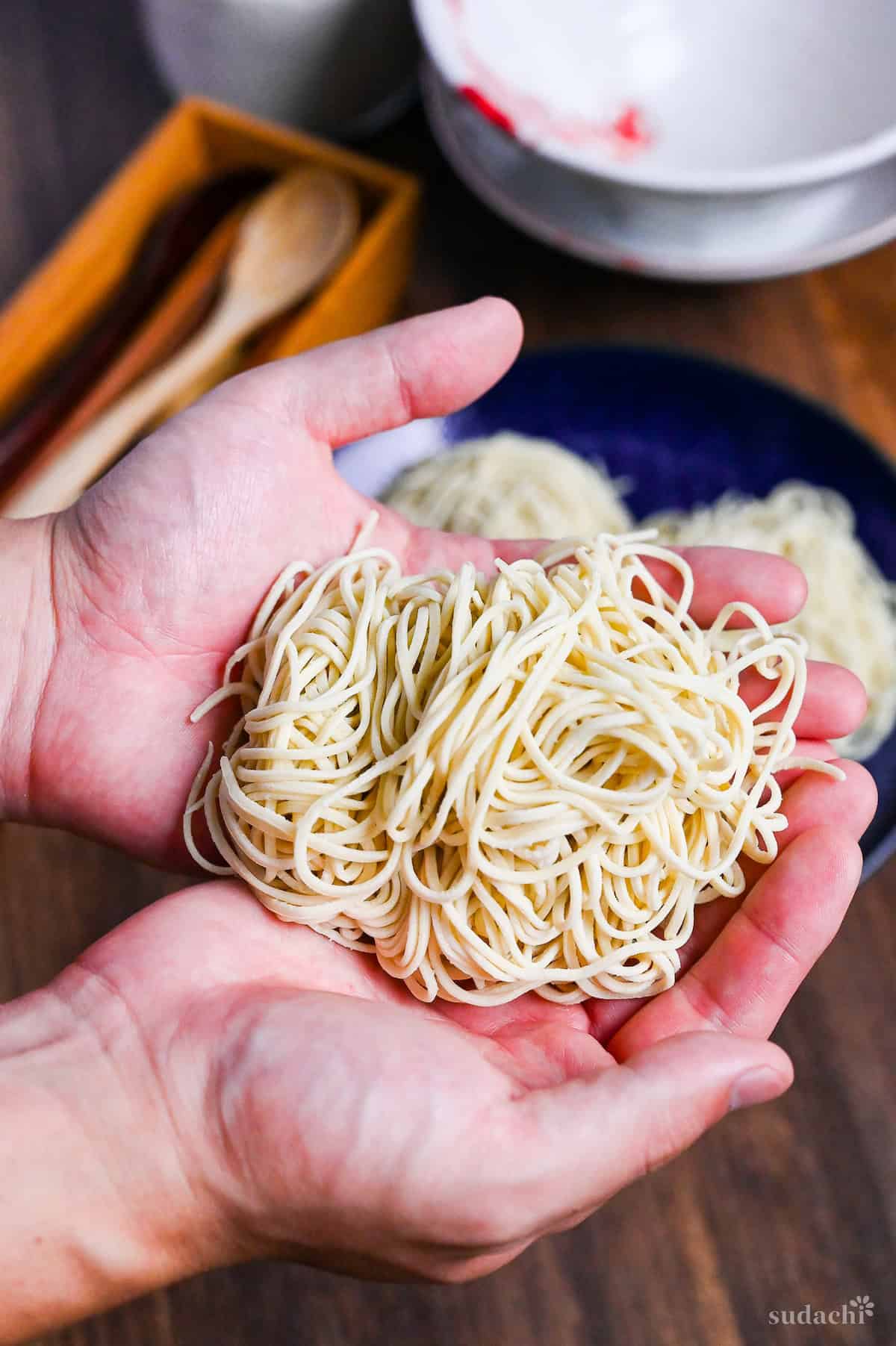
That said, I recently made a fail-proof recipe for homemade ramen. If you don’t mind spending time and want the best quality, then handmade is the BEST choice.
Using the noodles from packaged instant ramen
Another common workaround involves using dried, instant noodles from packets, for instance, Maruchan instant ramen. This method is undeniably straightforward. However, as I’ve previously emphasized, instant ramen and authentic ramen are similar yet entirely different.
While some instant soups and flavors have become unbelievably authentic these days, the most significant distinction lies in the noodles themselves. Ramen shops always serve fresh, raw noodles, made in-house or at a noodle mill, then boiled to perfection. In contrast, instant ramen noodles are essentially preserved food—dried and fried before packaging.
So, while I do appreciate instant ramen, it doesn’t quite capture the essence of ramen in Japan. Also, it is wasteful and expensive to buy instant ramen just to take the noodles and throw the seasonings away.
But don’t lose hope! In the next section, I’ll share a handy trick using spaghetti—a pantry staple more akin to genuine ramen than instant noodles.
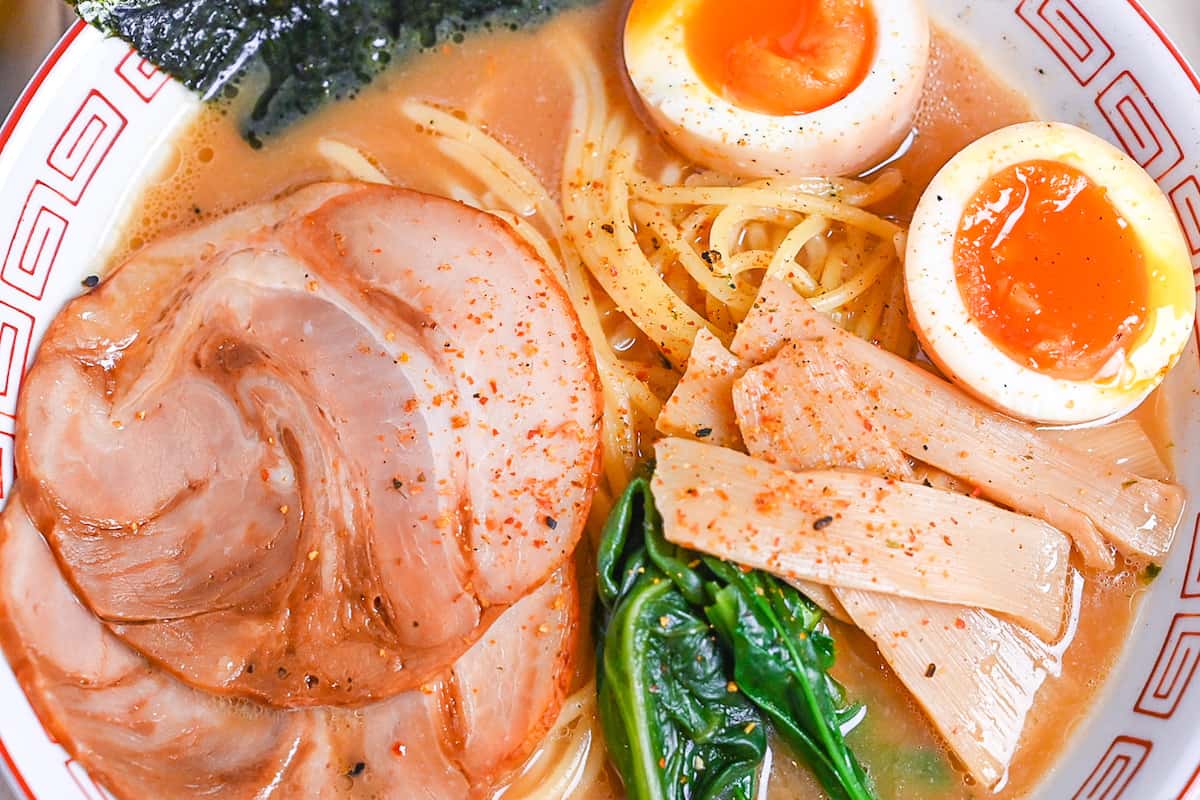
Ramen with spaghetti noodles
Following my homemade ramen adventure, I was nearly ready to abandon and ignore my ramen craving. But then, I stumbled upon an amazing workaround—making ramen noodles from spaghetti!
This hack is quite popular among many Japanese ramen lovers living abroad. I wish I’d discovered it sooner before turning my kitchen upside down with my earlier attempts!
The following section will explore how to morph your everyday spaghetti into a satisfying ramen noodle substitute. It’s simpler than you might imagine!
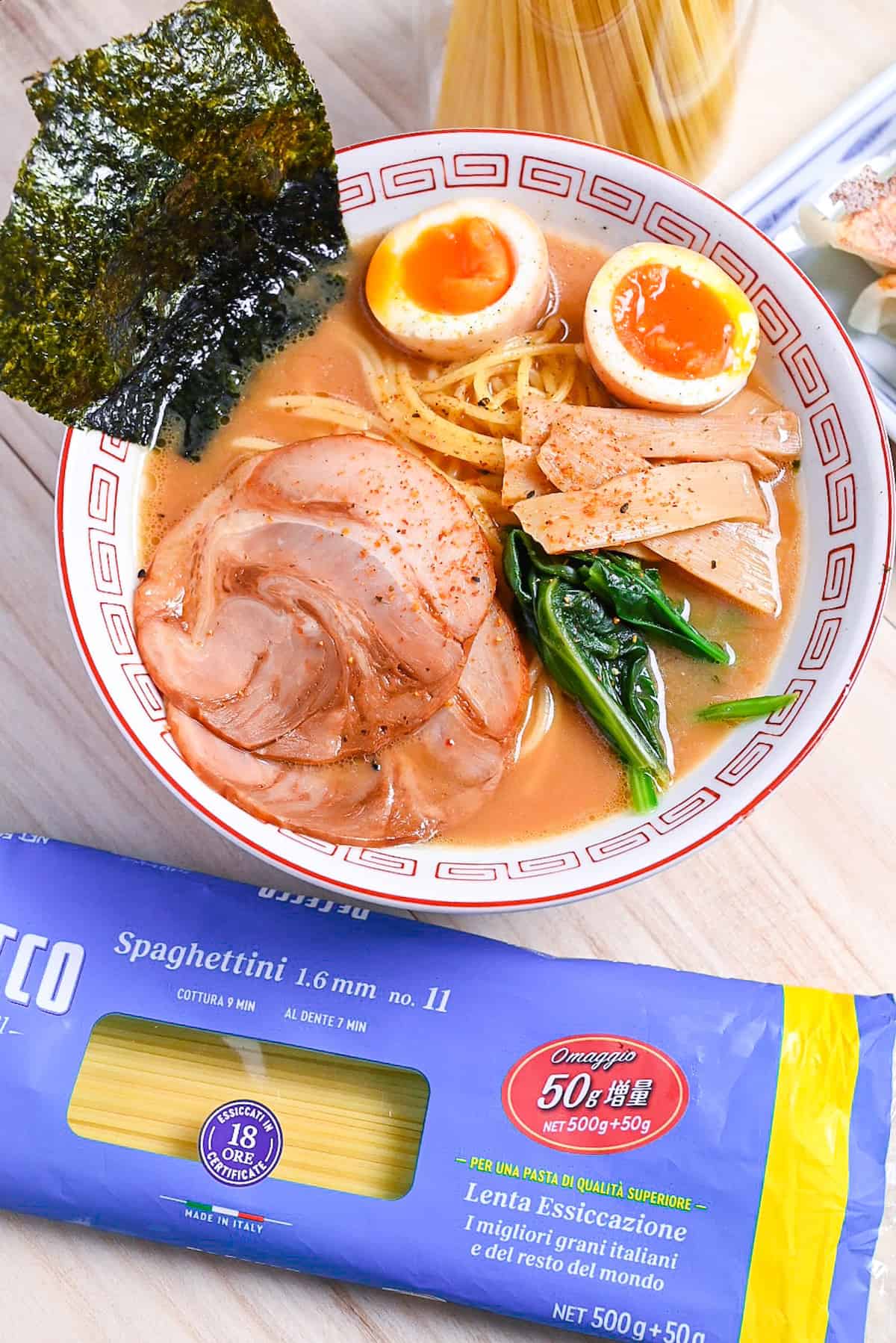
How to Make Ramen with Spaghetti Noodles
Here’s the surprising twist—this trick is not only my secret but also a well-loved hack among many Japanese people who, like me, can’t easily find premade fresh ramen noodles.
The secret lies in cooking regular spaghetti with a bit of baking soda! It’s as straightforward as that!
Before we proceed, it’s essential to clarify—this hack is not magic that will transform spaghetti into exact replicas of the noodles you’d find in a ramen restaurant. Instead, it’s the most convenient way to make something similar to ramen noodles abroad. Please keep this in mind as we dive into the details.
Furthermore, spaghetti is usually cheap and easily available in basically any country, so it is also economical. Don’t waste time buying instant ramen; just take out the noodles and throw away the soup!
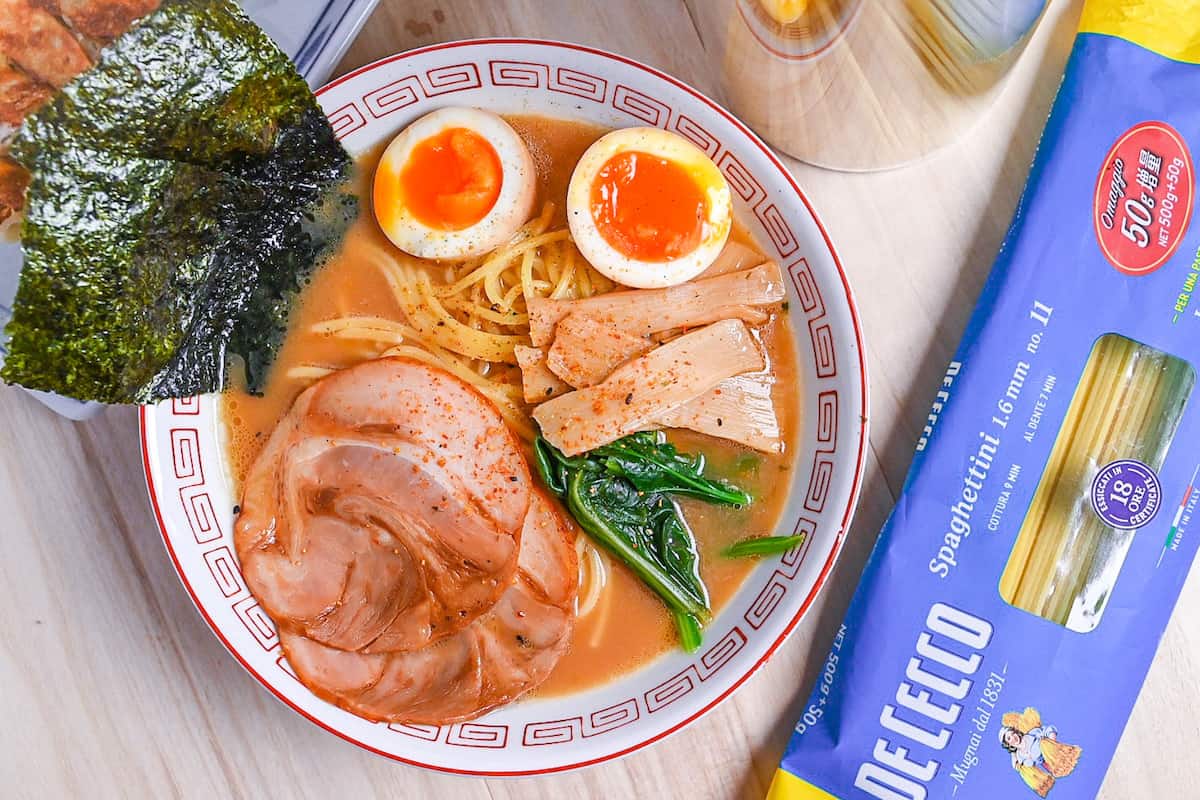
The Chemistry Behind The Ramen Hack
Ramen noodles owe their distinctive chewiness and yellowish hue to “lye water” known as “kansui” (かん水) in Japanese.” Lye water is an alkali salt solution mixed into the flour during preparation. Without it, you’d simply be kneading regular wheat flour into udon noodles. On the other hand, pasta lacks this lye water component, giving it a distinct texture that’s firmer and less chewy than ramen noodles.
The crucial ingredient in lye water is sodium carbonate. The thought process behind using baking soda while boiling pasta is to mimic a basic environment that encourages a reaction between the base and gluten—similar to the process of making ramen noodles in the first place.
Now, baking soda, or sodium bicarbonate, has extra hydrogen. However, it decomposes into sodium carbonate, water, and carbon dioxide when heated. Hence, the theory goes that boiling spaghetti with baking soda transforms into something similar to ramen noodles.
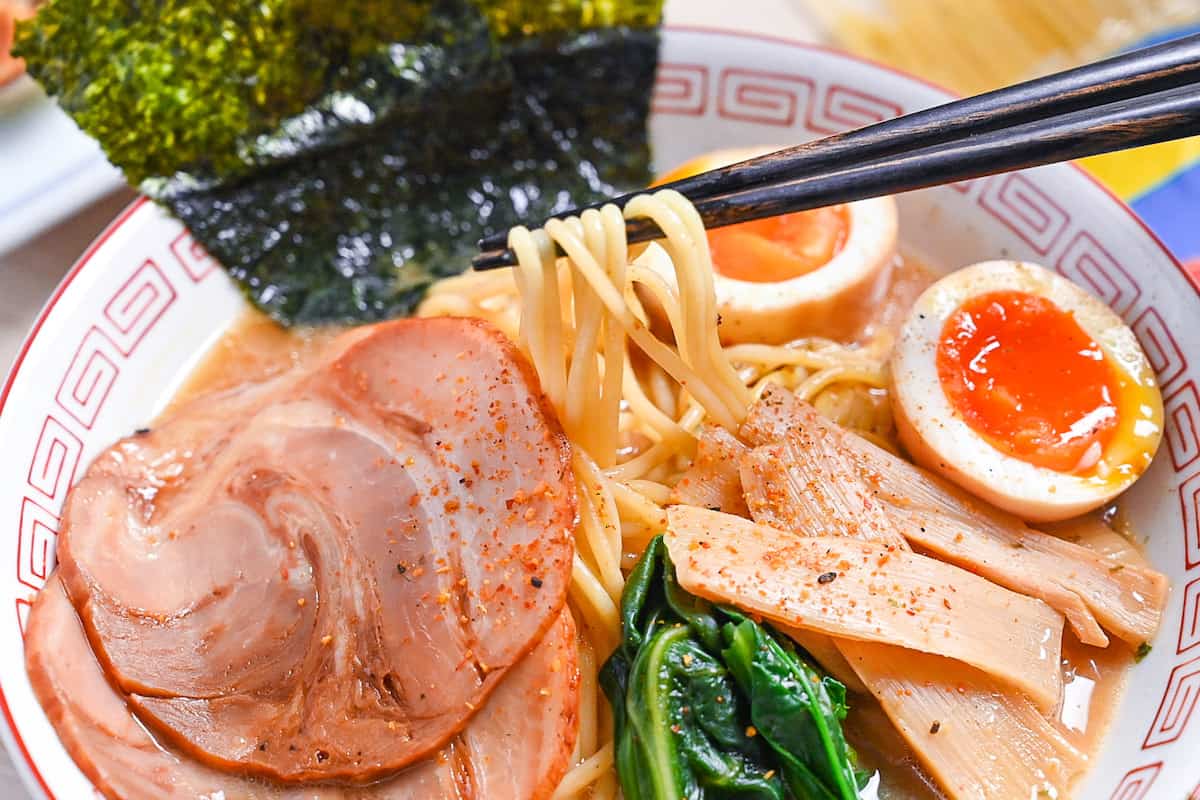
Ingredients & Substitution Ideas
- Dried long pasta – I recommend capellini for those who like extremely thin ramen noodles, spaghettini for those who like thin noodles, and spaghetti for those who like slightly thicker noodles. Generally from 1.0 mm to 1.8 mm thick would work depending on your preference.
- Water – Boil the noodles in plenty of water, just as you would boil ramen noodles.
- Salt – Add salt to the water, noodles need a bit of flavor too!
- Baking soda – Be sure to use baking soda, not baking powder. This hack will not work with baking powder. This is because baking powder contains a variety of substances other than sodium bicarbonate.
Curious about the exact brands and products that bring my recipes to life? Discover the brands and ingredients behind my recipes at the Sudachi Amazon Storefront. Explore my handpicked pantry essentials and find your next kitchen favorites!
Visual Walkthrough & Tips
Here are my step-by-step instructions for how to turn dried spaghetti into ramen noodles at home. For ingredient quantities and simplified instructions, scroll down for the printable recipe card below.
Bring a large pot of water to a rolling boil and add salt.
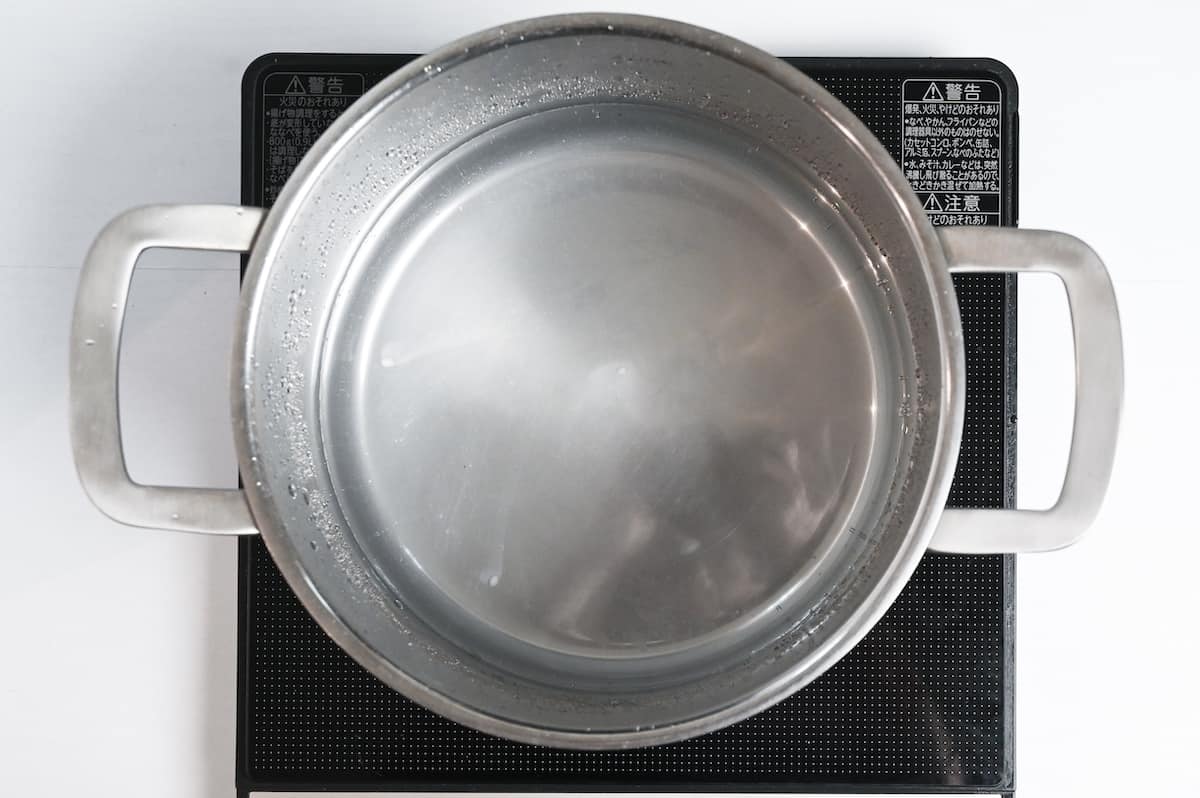
- Use plenty of water – pasta needs a lot of water because starch is released as it cooks, which can cause the pasta to stick together. Plenty of water dilutes the starch and gives the pasta more room to move around.
- Add salt – just because pasta is served in sauces (or in our case, ramen broths) doesn’t mean that it shouldn’t be seasoned. A little salt in the water will enhance the flavor of the pasta inside and out.
- Make sure the water is boiling before adding the pasta – adding pasta before your water is boiling will result in a mushy mess!
Once the water is boiling, add the baking soda and mix until it has dissolved. Then you can add your pasta. Boil for 2 minutes longer (if you use a thinner type, reduce the time a bit) than the time stated on the packaging.
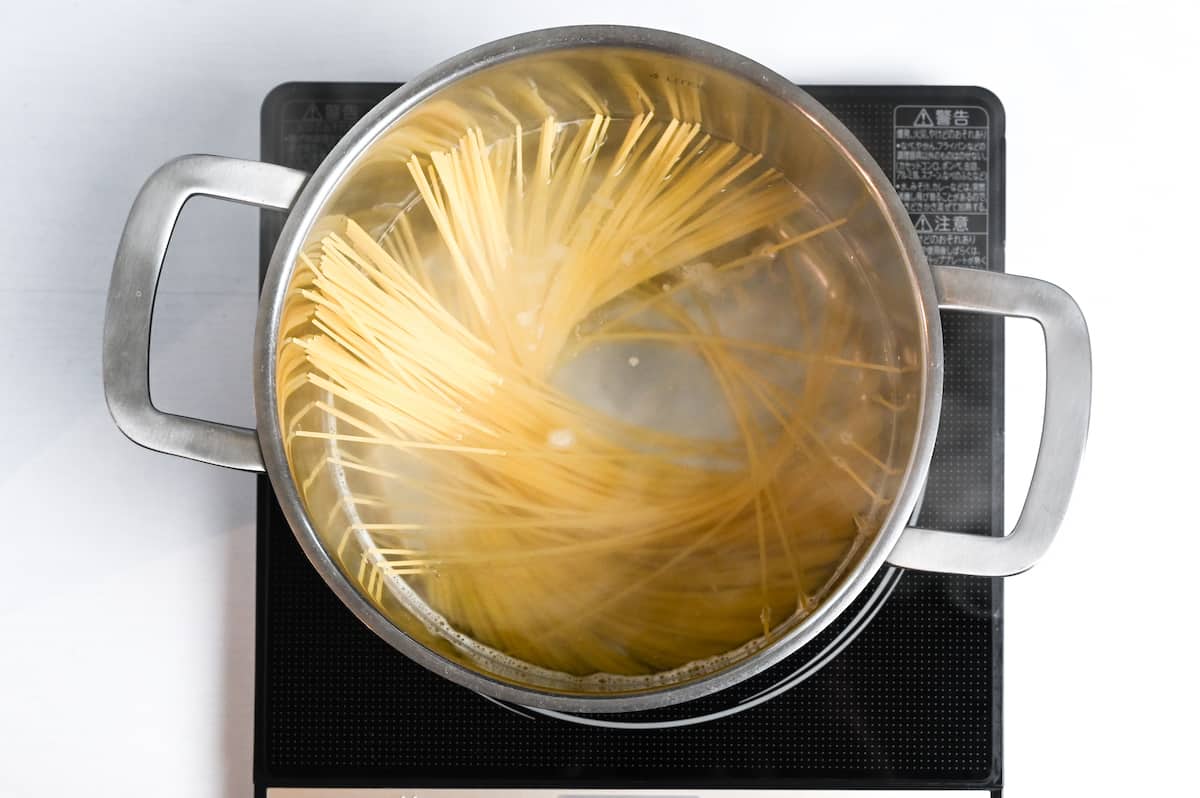
After boiling, place the noodles in a colander and rinse them thoroughly with tap water to remove any sliminess. If they are to be used for hot soup, washing them with hot water is OK.
It’s important to drain and rinse water boiled with baking soda in a colander to avoid a bitter taste or sliminess.
Once washed, place them in a bowl.
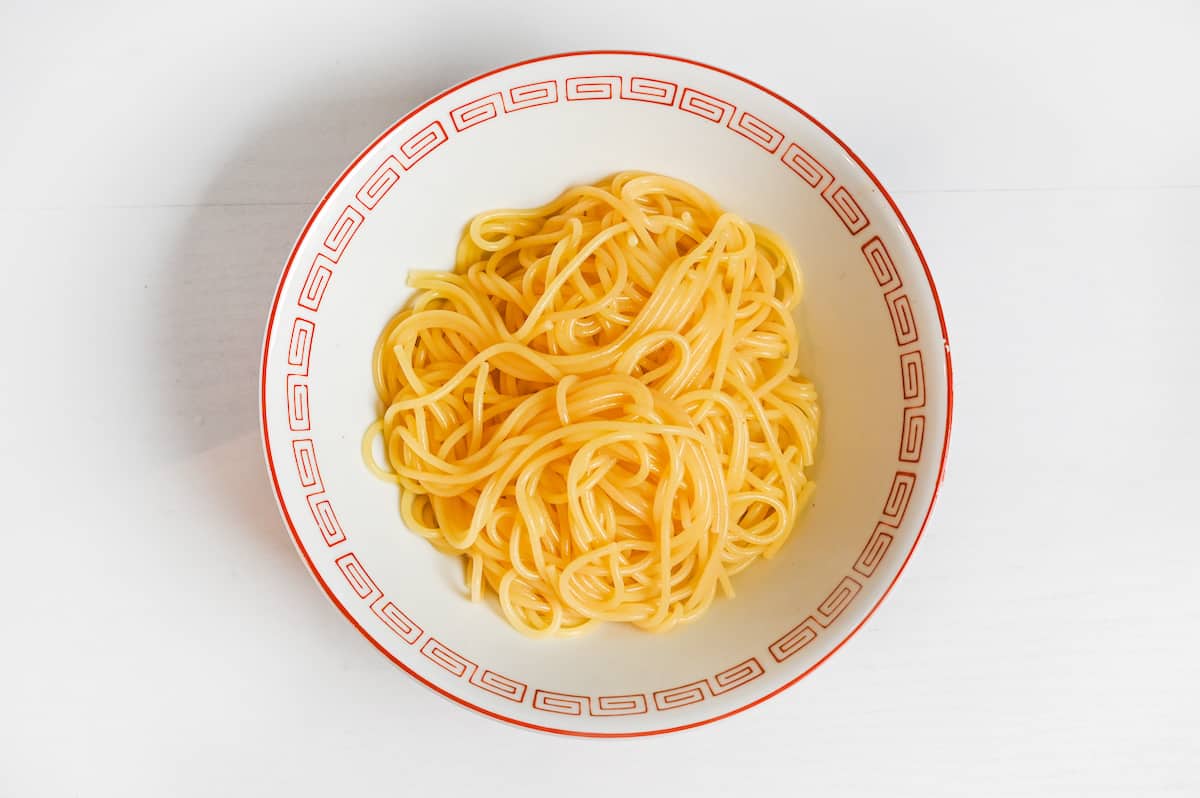
Enjoy your spaghetti-hack ramen with your favorite ramen broth and toppings!
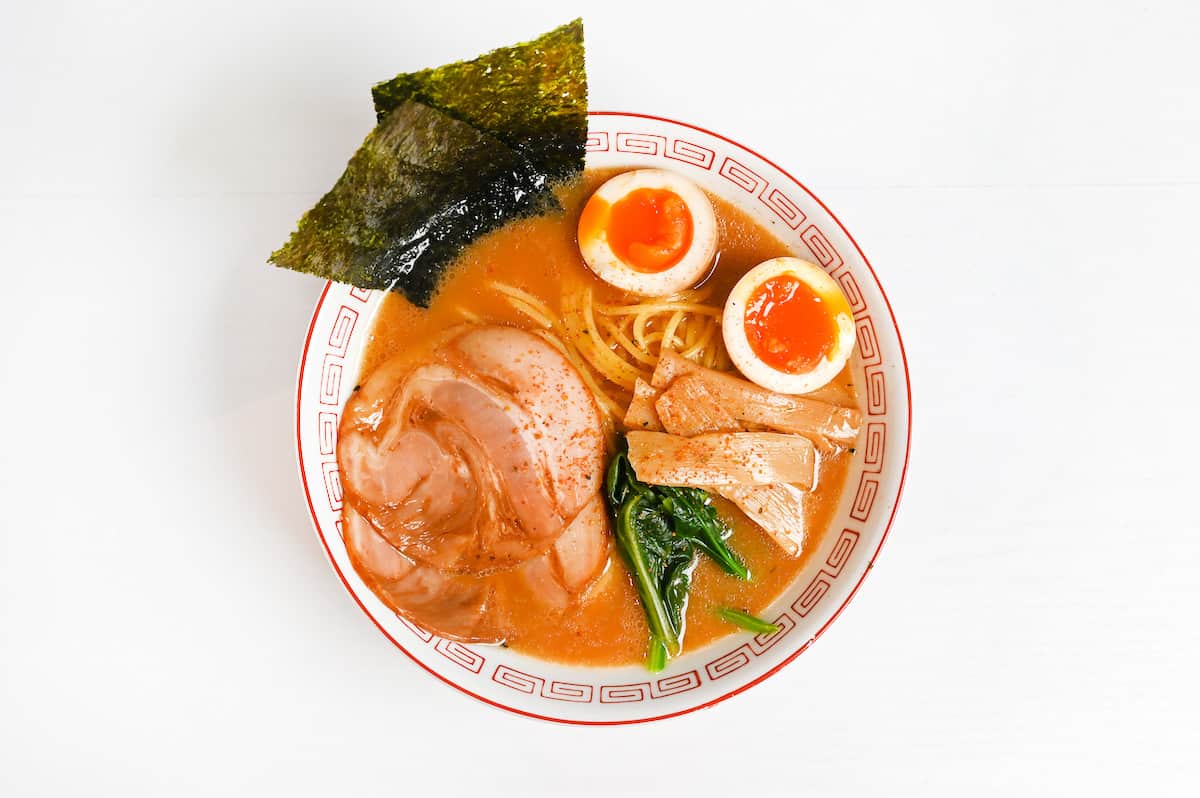
FAQ
Here are answers to frequently asked questions I have received across all platforms, including here, YouTube, and Pinterest. If you have any questions, feel free to send them to me anytime! It will be a big help for everyone in this community!
Yes, that’s right!
I hope you enjoy this recipe! If you try it out, I’d really appreciate it if you could spare a moment to let me know what you thought by giving a review and star rating in the comments below. It’s also helpful to share any adjustments you made to the recipe with our other readers. Thank you!
Recommended Ramen Recipes
Hungry for more? Explore my ramen soup recipe collection to find your next favorite dishes!
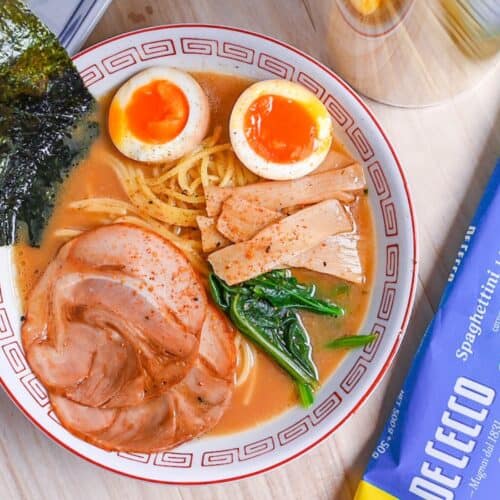
How to Make Ramen Noodle Using Spaghetti (Hack)
Ingredients
- 160 g dry spaghetti 1.0-1.8mm depending on your preference
- 2000 ml water
- ½ tsp salt
- 1 tbsp baking soda
My recommended brands of ingredients and seasonings can be found in my Japanese pantry guide.
Can’t find certain Japanese ingredients? See my substitution guide here.
Instructions
- First, fill a large pot with 2000 ml water and ½ tsp salt. Bring it to a rolling boil.

- Once it's boiling, add 1 tbsp baking soda and 160 g dry spaghetti. Boil for 2 minutes longer (if you use a thinner type, reduce the time a bit) than stated on the packaging.

- Pour the spaghetti into a colander and rinse with fresh water. Use hot water if you're serving it hot and cold water if serving it cold.

- Enjoy with your favorite ramen broth and toppings!

Video
Notes
- Use a large pot with at least 20cm diameter for boiling the noodles.
- Choose stainless steel or enamel pots instead of aluminum, as baking soda can cause discoloration.
- Watch for excessive foaming when adding baking soda to boiling water to prevent overflow.
- Always use food-grade baking soda.
- Select pasta thickness based on preference: capellini (thinnest), spaghettini (thin), or spaghetti (thicker), ranging from 1.0mm to 1.8mm.
- Thoroughly drain and rinse noodles in a colander to remove baking soda residue that can cause bitterness or sliminess.
- Recommended easy homemade soups to go with: Miso Ramen, Cheat’s Tonkotsu Ramen, Tantanmen, Abura Soba. Full ramen roundup here.
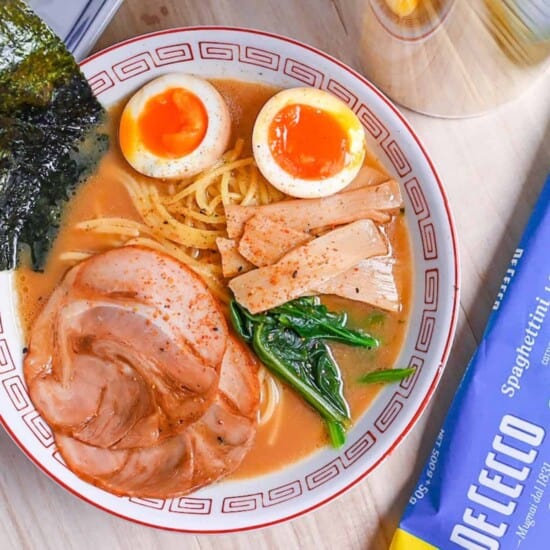



Great tip. I live in Norwich and there are a couple of good Japanese restaurants though I’m no expert.
You need to check the recipe as you mention tsp and tbsp of salt and there’s a big difference!
Love the site and your instagram.
Thanks!
Hi Andy,
Thank you very much for the comment!
Yes! There are a couple or a few good Japanese restaurants in Norwich! It’s more like I was always skint back then so I couldn’t really go to restaurants haha
And thank you for pointing that out, I’ve just fixed the tsp and tbsp measurement on the recipe. I really appreciate it 🙂
Thank you!
Love the hack! I’ve used just plain spaghetti noodle in a pinch before but now I’ll try this hack. And what might have you been doing all the way over there in Narrich? Studying at UEA? I’ve done a couple years there myself. I miss the place. The good news is there is also now a stall in the Norwich Market that sells Southeast Asian food and then Fair selection of ramans.
Thanks for sharing! I Came Upon This by accident but now I see lots of recipes I’m going to be checking out. Cheers mate
Thanks so much! Yeah I was at UEA for 4 years, I had a great time there! What a small world haha
I have a feeling that stall opened during my final year so I didn’t have time to make the most of it, but it’s great to hear they have a good selection. Is it reasonably priced?
Hope you enjoy the recipes and thanks for the 5 star review!
This will come in handy since I can’t have instant ramen (shellfish allergy that popped out of nowhere) and sometimes I crave a bowl of ramen.
Thank you for your comment and I’m sorry to hear about your allergy. But yes, this trick is handy for making your own ramen from scratch! 🙂
Thanks for the hack, I tried it with long curly spaghetti to make ramen at home, it was pretty good. Do you know if it also works with gluten free spaghetti? I have a friend who has coeliac and I’d like to make some ramen for her too.
Hi Didina, Thank you for the comment and rating! I’m glad the hack worked well for you.
I’ve never tried it with gluten free spaghetti, but because the hack relies on a reaction between the alkaline in the baking soda and the gluten in pasta, I think it probably wouldn’t work. Sorry I couldn’t be more helpful, I hope you can find a solution!
hello and thank you for this hack ^^
I made it and it was delicious <3
You’re welcome! Glad you enjoyed it 🙂
Hi Yuto, I found your website while looking for Yakisoba recipes. Also found your homemade Yakisoba Sauce and that was just sheer serendipity. It’s great. Have had it severalnow and will be having it again. Yakisoba is one of my favorite dishes. This evening I found your ramen hack–more serendipity. Definitely will be trying that with Bucatini noodles. Bucatini is like spaghetti, but it’s a bit fatter and has a hole that runs through the center, like a tube. Anyway great site. I could buy yakisoba sauce and ramen but that would be an hour and a half round trip. So glad I found your site. Thanks.
Hi, so glad you found my blog and are enjoying my recipes! I hope you enjoy the hack, I’ve never tried Bucatini noodles, let me know how it goes. Also thank you for the 5 star rating, much appreciated!
Have you tried making these ahead and refrigerating them, or do you think they would fall apart? Trying to work out how I could pack these for my daughter’s school lunch.
Hi Erin,
Thank you for your question! Unfortunately, I wouldn’t recommend storing these noodles. They likely won’t fall apart, but they probably dry out and clump together. If you want to make something ahead of time, the best shot would be preparing yakisoba (instead of soupy variations) using this noodle hack, then storing it. The stir-fried nature of yakisoba makes it potentially hold up better in refrigeration. I hope this helps!
Yuto
That does help, thank you!